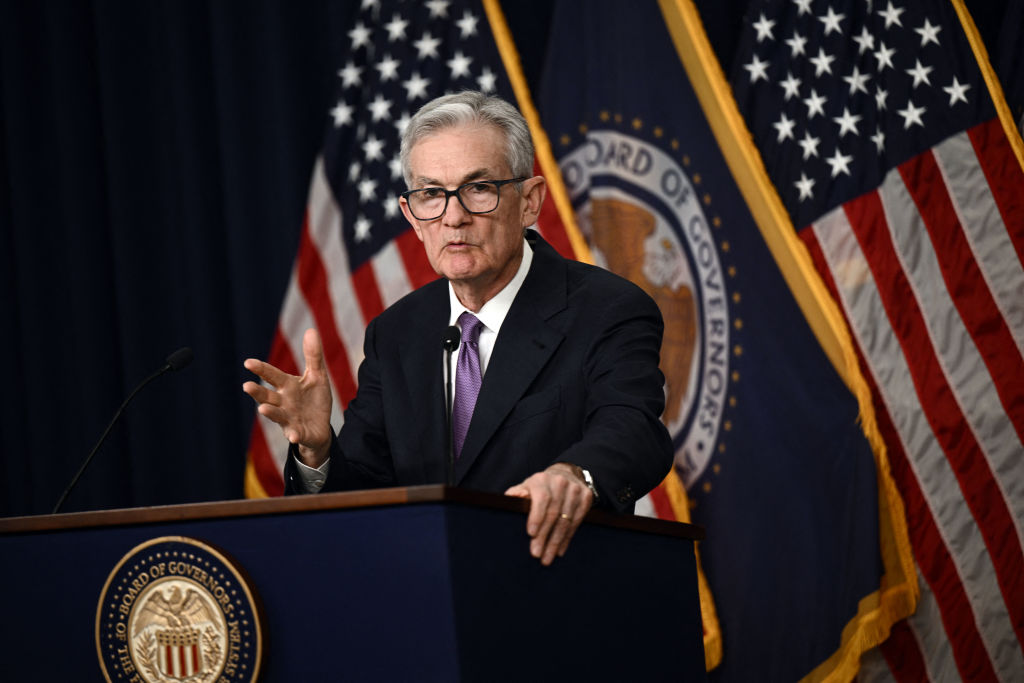How Does the Federal Reserve Work?
The central bank has an outsize impact on financial markets.

Eight times a year, a group of 19 bankers, finance experts and economists gather for a two-day confab in an elegant cream- and-gold boardroom about a mile from the White House. After they’re done analyzing the outlook for inflation and employment, Federal Reserve chairman Jerome Powell, the leader of the group known as the Federal Open Market Committee, emerges and announces what they have decided to set as a target range for short-term interest rates.
The committee’s goal — known as the dual mandate — is to set an interest rate that enables the economy to achieve price stability and full employment. It is enormously important to investors, savers, borrowers and business leaders whether — and how — the Fed achieves this delicate balance. Books have been written on how exactly the Federal Reserve influences investment markets, but here’s a quick and rough summary.
The first thing to understand is what the FOMC’s vague-sounding goals actually mean. Fed officials have said they consider the economy to have price stability when a Department of Commerce calculation of U.S. consumer spending, called the Personal Consumption Expenditures Price Index, rises by 2% a year.
From just $107.88 $24.99 for Kiplinger Personal Finance
Become a smarter, better informed investor. Subscribe from just $107.88 $24.99, plus get up to 4 Special Issues

Sign up for Kiplinger’s Free Newsletters
Profit and prosper with the best of expert advice on investing, taxes, retirement, personal finance and more - straight to your e-mail.
Profit and prosper with the best of expert advice - straight to your e-mail.
Fed economists like the PCE price index because it considers how shoppers substitute, say, lower-cost chicken when beef prices rise, thus reflecting the prices consumers actually pay. That’s one reason the PCE measure tends to run lower than the more widely cited consumer price index. As of December 2023, the CPI had risen 3.1% over the previous 12 months while the PCE price index was up 2.6%.
The Fed has not set a specific ideal full-employment number. Instead, Fed officials say they look at a variety of measures, such as wage trends and the percentages of workers employed in different population groups, to aim for the maximum employment level that doesn’t kick off wage inflation.
Tools the Fed has to use
The most powerful tool the Fed has to achieve those goals is the influence it has on short-term interest rates. When the Fed meeting happens and the FOMC announces its target range for the federal funds rate, it is indicating what it wants banks to charge each other for lending or borrowing cash overnight.
But the Fed can’t force banks to charge each other its chosen interest rate. Instead, it steers banks toward the target by adjusting the interest rates it pays to and charges from banks for the reserves that banks are required to keep with the Fed and any overnight Fed loans to member banks.
Maneuvering all of the nation’s 4,600 banks to its ideal interest rate isn’t an exact science, hence the target range for the federal funds rate, spanning roughly a quarter of a percentage point. As of December 31, the range was between 5.25% and 5.5%.
The federal funds rate is essentially a floor for all other interest rates in the economy. For example, the prime rate, which is the rate banks charge their best customers, is typically set three percentage points above the high end of the federal funds target rate. And the prime rate serves as a floor for many bank lending rates, including credit cards and auto loans.
If inflation continues to moderate and the economy continues on its current steady trajectory, Powell said in December that the FOMC would aim to lower the midpoint of the federal funds target range to roughly 4.6% by the end of 2024 and 3.6% at the end of 2025. But almost immediately after his announcement, investors in the futures market started betting that the FOMC would start cutting the federal funds rate as soon as March and would drop the rate to 4% or below by year-end 2024.

To influence longer-term interest rates, the Fed has another strategy: managing the securities it keeps on its balance sheet. In an effort to lessen the pain of the 2008 Great Recession and, later, the COVID shutdowns, the Fed sought to drive down long-term interest rates by buying up trillions of dollars of Treasury bonds and mortgage-backed securities.
The massive purchases helped push bond prices higher and send yields, which move in the opposite direction, lower. The process, quantitative easing, helped drive interest rates on the 10-year Treasury bond to as low as 0.55% in 2020.
But as inflation took off, the Fed made a U-turn and, starting in 2022, strove instead to cool the economy by pushing up rates, raising borrowing costs. It switched to quantitative tightening, allowing some bonds in its portfolio to mature each month without replacing them — recently, to the tune of about $95 billion a month.
By reducing its purchases, the Fed relied on lower demand to cool bond prices, allowing long-term rates to rise. The Fed has reduced the total value of securities on its balance sheet by $1 trillion, to $7.7 trillion, since March of 2023, and it has indicated it hopes to run off another $1 trillion in 2024. As quantitative tightening winds down, the Fed’s influence on longer-term rates is diminishing.
The Fed prepares for landing
The market impact of Fed actions can be immediate. The recent announcement of a pivot from hiking to anticipated cutting was met with what some veteran Fed watchers worry is a bit of irrational exuberance (a phrase coined by former Fed chairman Alan Greenspan). A number of stock indexes hit new highs, and bonds rallied as investors cheered the possibility that the Federal Reserve had pulled off a difficult “soft landing,” raising interest rates enough to cut inflation without setting off a recession.
“This was a very thin needle to thread,” because Federal Reserve interest rate hikes have caused most of the recessions in the past 50 years, says Mark Zandi, chief economist of Moody’s Analytics. Barring a shock such as an energy price spike or worsening geopolitical hostilities, “they may have pulled it off,” he says.
After the announcement, Jay Hatfield, chief executive officer of Infrastructure Capital Advisors, raised his forecast for the S&P 500 from 5150 at year-end 2024 to 5500. “We think both stocks and bonds are going to do really well in 2024,” he says.
Despite Wall Street’s celebratory mood, however, it’s important to note that the soft landing has not actually touched down yet and that interest rates are notoriously difficult to predict. That’s why many financial-market strategists remain circumspect.
Pramod Atluri, a fixed income portfolio manager for the Capital Group, is urging investors to start putting sidelined money to work but favors high-quality fare such as Treasuries and agency-backed mortgage bonds. As for stocks, Robert Almeida, a global investment strategist for MFS Investment Management, is focusing on higher-quality companies that can sustain profitability — no matter what the Fed does.
Note: This item first appeared in Kiplinger's Personal Finance Magazine, a monthly, trustworthy source of advice and guidance. Subscribe to help you make more money and keep more of the money you make here.
Related Content
Profit and prosper with the best of Kiplinger's advice on investing, taxes, retirement, personal finance and much more. Delivered daily. Enter your email in the box and click Sign Me Up.

Kim Clark is a veteran financial journalist who has worked at Fortune, U.S News & World Report and Money magazines. She was part of a team that won a Gerald Loeb award for coverage of elder finances, and she won the Education Writers Association's top magazine investigative prize for exposing insurance agents who used false claims about college financial aid to sell policies. As a Kiplinger Fellow at Ohio State University, she studied delivery of digital news and information. Most recently, she worked as a deputy director of the Education Writers Association, leading the training of higher education journalists around the country. She is also a prize-winning gardener, and in her spare time, picks up litter.
-
 Stocks Slip to Start Fed Week: Stock Market Today
Stocks Slip to Start Fed Week: Stock Market TodayWhile a rate cut is widely expected this week, uncertainty is building around the Fed's future plans for monetary policy.
-
 December Fed Meeting: Live Updates and Commentary
December Fed Meeting: Live Updates and CommentaryThe December Fed meeting is one of the last key economic events of 2025, with Wall Street closely watching what Chair Powell & Co. will do about interest rates.
-
 This Is Why Investors Shouldn't Romanticize Bitcoin
This Is Why Investors Shouldn't Romanticize BitcoinInvestors should treat bitcoin as the high-risk asset it is. A look at the data indicates a small portfolio allocation for most investors would be the safest.
-
 Stocks Slip to Start Fed Week: Stock Market Today
Stocks Slip to Start Fed Week: Stock Market TodayWhile a rate cut is widely expected this week, uncertainty is building around the Fed's future plans for monetary policy.
-
 December Fed Meeting: Live Updates and Commentary
December Fed Meeting: Live Updates and CommentaryThe December Fed meeting is one of the last key economic events of 2025, with Wall Street closely watching what Chair Powell & Co. will do about interest rates.
-
 Why Investors Shouldn't Romanticize Bitcoin, From a Financial Planner
Why Investors Shouldn't Romanticize Bitcoin, From a Financial PlannerInvestors should treat bitcoin as the high-risk asset it is. A look at the data indicates a small portfolio allocation for most investors would be the safest.
-
 I'm a Financial Pro Focused on Federal Benefits: These Are the 2 Questions I Answer a Lot
I'm a Financial Pro Focused on Federal Benefits: These Are the 2 Questions I Answer a LotMany federal employees ask about rolling a TSP into an IRA and parsing options for survivor benefits, both especially critical topics.
-
 Private Credit Can Be a Resilient Income Strategy for a Volatile Market: A Guide for Financial Advisers
Private Credit Can Be a Resilient Income Strategy for a Volatile Market: A Guide for Financial AdvisersAdvisers are increasingly turning to private credit such as asset-based and real estate lending for elevated yields and protection backed by tangible assets.
-
 5 RMD Mistakes That Could Cost You Big-Time: Even Seasoned Retirees Slip Up
5 RMD Mistakes That Could Cost You Big-Time: Even Seasoned Retirees Slip UpThe five biggest RMD mistakes retirees make show that tax-smart retirement planning should start well before you hit the age your first RMD is due.
-
 I'm a Wealth Adviser: My 4 Guiding Principles Could Help You Plan for Retirement Whether You Have $10,000 or $10 Million
I'm a Wealth Adviser: My 4 Guiding Principles Could Help You Plan for Retirement Whether You Have $10,000 or $10 MillionRegardless of your net worth, you deserve a detailed retirement plan backed by a solid understanding of your finances.
-
 A Retirement Triple Play: These 3 Tax Breaks Could Lower Your 2026 Bill
A Retirement Triple Play: These 3 Tax Breaks Could Lower Your 2026 BillGood news for older taxpayers: Standard deductions are higher, there's a temporary 'bonus deduction' for older folks, and income thresholds have been raised.
